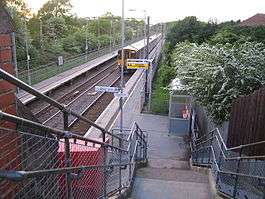Watton-at-Stone railway station
Watton-at-Stone railway station serves the village of Watton-at-Stone in Hertfordshire, England. It is 23 miles 72 chains (38.46 km) down the line from London King's Cross[1] on the Hertford Loop Line between Hertford North and Stevenage and is served by trains operated by Great Northern.
| Watton-at-Stone | |
|---|---|
 | |
| Location | |
| Place | Watton-at-Stone |
| Local authority | District of East Hertfordshire |
| Coordinates | 51.8569°N 0.1198°W |
| Grid reference | TL295192 |
| Operations | |
| Station code | WAS |
| Managed by | Great Northern |
| Number of platforms | 2 |
| DfT category | E |
| Live arrivals/departures, station information and onward connections from National Rail Enquiries | |
| Annual rail passenger usage* | |
| 2014/15 | |
| 2015/16 | |
| 2016/17 | |
| 2017/18 | |
| 2018/19 | |
| History | |
| Original company | London and North Eastern Railway |
| Post-grouping | London and North Eastern Railway |
| 2 June 1924 | Opened |
| 10 September 1939 | Closed |
| 17 May 1982 | Reopened |
| National Rail – UK railway stations | |
| * Annual estimated passenger usage based on sales of tickets in stated financial year(s) which end or originate at Watton-at-Stone from Office of Rail and Road statistics. Methodology may vary year on year. | |
History
According to the Watton-at-Stone Parish Council,[2] a proposal for a rail route between London and Stevenage was approved by Parliament in 1898, though construction did not begin until 1906. A single-track section through Watton-at-Stone opened on 4 March 1918, with the track later being dualled.
The station saw its first passenger train run through on 6 February 1920, but did so only when a train was diverted from the East Coast Main Line as the result of an accident. Scheduled passenger services of four trains per day started on 2 June 1924, stopping on request at Watton-at-Stone.
The station's life as a passenger service was short-lived however, and it closed just 15 years later on 10 September 1939, despite the famed locomotive engineer Nigel Gresley's residency in the village.
The nationalised British Railways considered reopening the station in the 1960s, but it was not until 1981 that a campaign to reopen the station gathered momentum. The bulk of the £120,000 costs were paid for by Hertfordshire County Council and British Rail, but villagers and the parish council responded to a public appeal for funds, and together contributed £8,000. On 17 May 1982, a small crowd gathered to board the 06:23 service from Watton-at-Stone to Moorgate, the first passenger train to serve the village in almost 43 years.
Services
Prior to the May 2019 timetable change, the station was served by two trains per hour towards Moorgate and 1 tph to Stevenage; however during peak times this increases up to three trains an hour in each direction. Southbound trains for London run to Moorgate, whilst northbound trains generally terminate at the next stop on the line, Stevenage, apart from selected weekday trains which continue to Hitchin before terminating at Letchworth Garden City.
Since then, Great Northern has stopped running through to Stevenage and beyond on weekdays whilst upgrade works (to add an additional running line and terminal platform) are carried out at Stevenage station. An hourly replacement bus is in operation until the work is completed in spring 2020.[3] An hourly train service continues to operate over this section at weekends. The twice-hourly service to Hertford North and Moorgate continues as normal on weekdays.[4]
| Preceding station | Following station | |||
|---|---|---|---|---|
| Hertford North | Great Northern Hertford Loop Line |
Stevenage | ||
| Historical railways | ||||
| Stapleford Line open, station closed |
London and North Eastern Railway Hertford Loop Line |
Stevenage Line and station open | ||
The Finishing Line
In 1977, track in the vicinity of the then closed station was used by British Transport Films as a set to film the notorious public information film The Finishing Line.[5] Using shock tactics to deter children from playing near railway lines, the film was staged as a dream sequence of a parody school sports day with 'events' on and around the track. Local schoolchildren were drafted as actors. The film was broadcast on the nightly Nationwide TV show, and the liberal quantities of stage blood and graphic depiction of injuries became a matter of some controversy.
References
- Padgett, David (October 2016) [1988]. Brailsford, Martyn (ed.). Railway Track Diagrams 2: Eastern (4th ed.). Frome: Trackmaps. map 24B. ISBN 978-0-9549866-8-1.CS1 maint: ref=harv (link)
- Watton-at-Stone Parish Council: Transport
- "From 20 May 2019 buses replace trains from Monday-Friday between Stevenage and Watton-at-Stone"Great Northern website news article; Retrieved 24 July 2019
- Table 21 National Rail timetable, May 2019
- British Transport Films: The Finishing Line
External links
- Train times and station information for Watton-at-Stone railway station from National Rail
- Other map sources for grid reference TL296192 (coordinates 51.8566°N 0.1192°W)
- Movie of steam train Duke of Gloucester passing through Watton-at-Stone